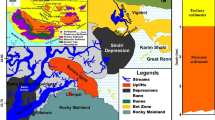Abstract
Regional gravity anomaly maps of Korea have been used for geologic information on the nature of crust and isostasy. We made an attempt to interpret the Bouguer map based on the nature, quality, and characteristics of anomalies and integrate the data with the geologic and tectonic features. Seismicity is also considered for the correlation with the Bouguer map. It reveals that the gravity anomaly map helps delineate major tectonic boundaries. It is observed that the gravity high zones are associated with earthquake activity and lineaments in their proximity.
Similar content being viewed by others
References
Choi, K.S., 1988, Gravity and crustal structure. In: Lee, D.S. (ed.), Geology of Korea. Geological Society of Korea & Kyohak-Sa Publishing Co., Seoul, p. 264–269.
Choi, K.S., Kong, Y.S. and Lee, H.K., 1993. A study on the crustal structure in and around the Korea peninsula by analysing gravity data. Journal of Korean Earth Science Society, 14, 2, 225–230.
Choi, K.S. and Shin Y.H., 1996, Isostasy in and around the Korean Peninsula by analysing gravity and topography data. Journal of the Geological Society of Korea, 32, 407–420.
Fukuda, 1990, Precise determination of local gravity field using both satellite altimeter data and the surface gravity data. Bulletin of Ocean Research Institute, University of Tokyo, 12, 1–133.
Korea Institute of Geology, Mining and Materials, 1995, Geological Map of Korea (1∶1,000,000). Korea Institute of Geology, Mining and Materials, Taejon.
Kumagai, N., 1953, Results of measurements of gravity in Japan and her vicinity. Special publication from faculty of science, Kyoto University, 8 p.
Kyung, J.B., 1989, The Characteristics of the Seismicity of the Korean Peninsula. Ph.D. thesis, Seoul National University, Seoul, 237 p.
Kyung, J.B., 1993, Correlation of earthquake occurrences with topography and lineaments in South Korea. Journal of Korean Earth Science Society, 14, 482–491.
Kwon, B.D. and Yang, S.Y., 1985, A study on the crustal structure of the southern Korean peninsula through gravity analysis. Journal of Korean Institute of Mining Geology, 18, 309–320.
Lee, K.H., 1979, On isostasy of the Korean peninsula. Journal of the Geological Society of Korea, 15, 134–140.
Lee, K.H. and Na, S.H., 1983, A study of microearthquake activity of the Yangsan Fault. Journal of the Geological Society of Korea, 19, 127–135.
Lee, K. and Jin, Y.G., 1989, A probabilistic analysis of the seismic risk in Korea (II). Journal of the Geological Society of Korea, 25, 59–71.
Lee, J.H., 1998, Statistical Analysis of the Seismicity of the Korean Peninsula. Ph.D. thesis, Seoul National University, Seoul, 110 p.
Min, K.D. and Chung, C.D., 1985, Gravity survey on the subsurface structure between Waekwan-Pohang in Kyoungsang basin. Journal of the Korean Institute of Mining Geology, 18, 321–239. (in Korean with English abstract)
Woollard, G.P. and Rose, J., 1963, International Gravity Measurements. Society of Exploration Geophysicists, Tulsa, 518 p.
Author information
Authors and Affiliations
Corresponding author
Rights and permissions
About this article
Cite this article
Choi, K.S., Kumar, G.V.R. & Kim, K.Y. Qualitative interpretation of Bouguer anomaly in the southern part of the Korean peninsula. Geosci J 3, 49–54 (1999). https://doi.org/10.1007/BF02910234
Received:
Accepted:
Issue Date:
DOI: https://doi.org/10.1007/BF02910234



